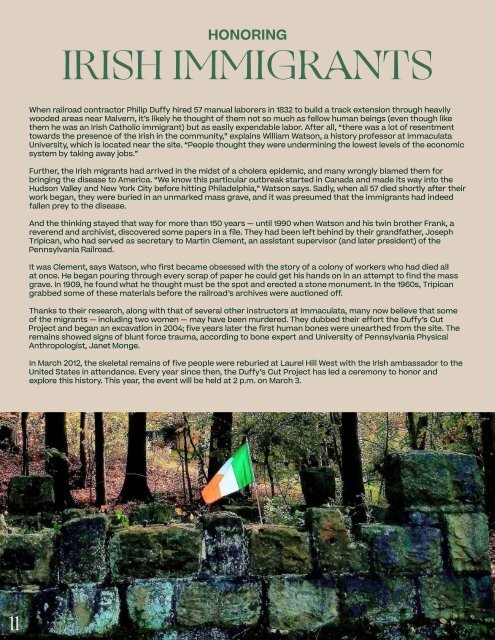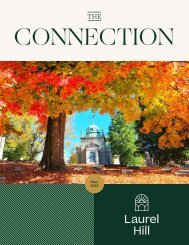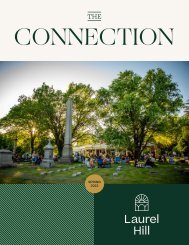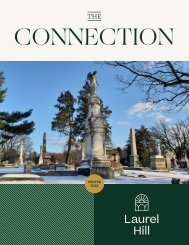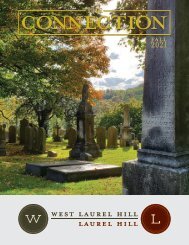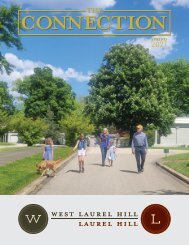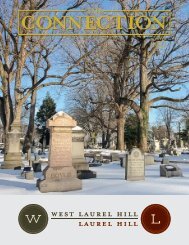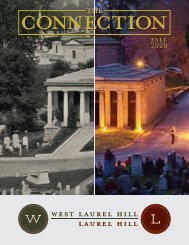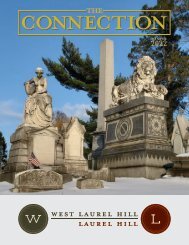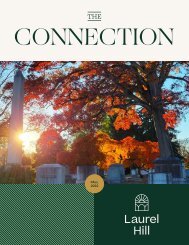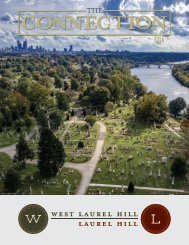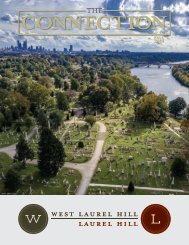The Connection - Winter 2024
The Connection is the official newsletter of Laurel Hill which provides you with updates and information on our entire organization, including happenings at our cemeteries, historical and educational facts, upcoming events, achievements and awards and of course, magnificent photos showcasing the beauty of both sites. If you’d like to receive a hard copy of the newsletter, please email jsweeney@laurelhillphl.com.
The Connection is the official newsletter of Laurel Hill which provides you with updates and information on our entire organization, including happenings at our cemeteries, historical and educational facts, upcoming events, achievements and awards and of course, magnificent photos showcasing the beauty of both sites. If you’d like to receive a hard copy of the newsletter, please email jsweeney@laurelhillphl.com.
- No tags were found...
You also want an ePaper? Increase the reach of your titles
YUMPU automatically turns print PDFs into web optimized ePapers that Google loves.
HONORING<br />
IRISH IMMIGRANTS<br />
When railroad contractor Philip Duffy hired 57 manual laborers in 1832 to build a track extension through heavily<br />
wooded areas near Malvern, it's likely he thought of them not so much as fellow human beings (even though like<br />
them he was an Irish Catholic immigrant) but as easily expendable labor. After all, "there was a lot of resentment<br />
towards the presence of the Irish in the community," explains William Watson, a history professor at lmmaculata<br />
University, which is located near the site. "People thought they were undermining the lowest levels of the economic<br />
system by taking away jobs."<br />
Further, the Irish migrants had arrived in the midst of a cholera epidemic, and many wrongly blamed them for<br />
bringing the disease to America. "We know this particular outbreak started in Canada and made its way into the<br />
Hudson Valley and New York City before hitting Philadelphia," Watson says. Sadly, when all 57 died shortly after their<br />
work began, they were buried in an unmarked mass grave, and it was presumed that the immigrants had indeed<br />
fallen prey to the disease.<br />
And the thinking stayed that way for more than 150 years - until 1990 when Watson and his twin brother Frank, a<br />
reverend and archivist, discovered some papers in a file. <strong>The</strong>y had been left behind by their grandfather, Joseph<br />
Tripican, who had served as secretary to Martin Clement, an assistant supervisor (and later president) of the<br />
Pennsylvania Railroad.<br />
It was Clement, says Watson, who first became obsessed with the story of a colony of workers who had died all<br />
at once. He began pouring through every scrap of paper he could get his hands on in an attempt to find the mass<br />
grave. In 1909, he found what he thought must be the spot and erected a stone monument. In the 1960s, Tripican<br />
grabbed some of these materials before the railroad's archives were auctioned off.<br />
Thanks to their research, along with that of several other instructors at lmmaculata, many now believe that some<br />
of the migrants - including two women - may have been murdered. <strong>The</strong>y dubbed their effort the Duffy's Cut<br />
Project and began an excavation in 2004; five years later the first human bones were unearthed from the site. <strong>The</strong><br />
remains showed signs of blunt force trauma, according to bone expert and University of Pennsylvania Physical<br />
Anthropologist, Janet Monge.<br />
In March 2012, the skeletal remains of five people were reburied at Laurel Hill West with the Irish ambassador to the<br />
United States in attendance. Every year since then, the Duffy's Cut Project has led a ceremony to honor and<br />
explore this history. This year, the event will be held at 2 p.m. on March 3.


